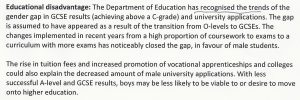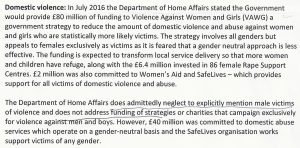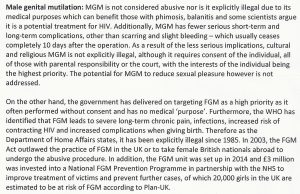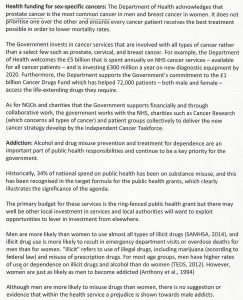A friend recently had an audience with his MP (a conservative), specifically to raise issues of disadvantage to men and boys. He used as his opening gambit Andrea Leadsom’s advice that men should not be hired to do childcare as they may be paedophiles. However, this was a pretext to introduce the whole swathe of male disadvantages (and good on him, I say). By all accounts it was a friendly conversation and the MP seemed very receptive. Of course, an MP is hardly likely to want a rancorous exchange with a voter. The MP was good enough to provide a written response to the issues raised. You will be unamazed at the nature of the written responses (which form the subject of this post). One presumes that it was a researcher who actually drafted the responses.
I thought it would be worth giving the contents of the letter an airing – and not only to provide me with the opportunity to refute it – but because I suspect it typifies what you will get back from ‘the establishment’ when they are confronted, however nicely, with men’s or boys’ issues. In summary the responses amount to “we don’t think you really have any issues of significance”. Whether this response is born of ignorance, indifference, mindless obedience to an approved narrative or just plain nastiness I cannot say.
So, is there any point in discussing these matters with your MP if that’s all the understanding which emerges? It would be easy to be discouraged. And an MP will readily dismiss a single visitor as irrelevant. But I rather think that it would become worthwhile if enough people did it. The same MP being approached by several, reasonable, people on the same subject may begin to get the message. Who knows? I oscillate between such outrageous optimism and the very opposite. Mostly the opposite, admittedly.
So, to the letter, which is shown point by point below as scanned images. I respond to each of the points in turn. You may assume that the men’s movement’s position was presented competently to the MP in the discussion and the letter responds to this.
Educational Disadvantage (click to enlarge & read)
The DoE “has recognised the trends”. Well, they could hardly fail to, but there is no intention to address these trends. In response to an FoI enquiry raised by J4MB, “Does the DoE recognize boys’ underachievement as a problem to be addressed, and if so, what initiatives are in place, and how much is budgeted for them in 2015/16?” the DoE stated in July 2015, “The Department does not fund any initiatives that just focus on addressing boys’ underachievement.” The concern in education at all levels is entirely for women and girls, whilst the needs of boys and young men are simply ignored, as laid out here and here and here and here and here and here and here and here.
The letter states, “the changes implemented in recent years from a high proportion of coursework to exams to a curriculum with more exams has noticeably closed the gap (in GCSE achievement) in favour of males“. Eh? My understanding is that next year, 2017, will be the first year that the change to minimal coursework will apply. As for this year, 2016, the gender gap at GCSE has increased again, I quote, “the gender gap has widened further – with 71.3% of entries by girls getting a C grade or above compared with 62.4% of boys.” As for next year when coursework gets kicked out, I expect we will indeed see a reduction in the gender gap – but only to a degree. There are other reasons for boys’ under-performance which will not be so easily addressed.
Over 90,000 more women applied for a university course this year than men, while the number of male applicants fell. Women outnumber men in two-thirds of degree subjects in the UK, and females are awarded 35% more degrees. The head of UCAS, Mary Curnock Cook, has raised the alarm about the disadvantage to men in higher education for the third year running now. Clearly this MP hasn’t got the message.
Domestic Violence (DV) (click to enlarge & read)
Here we go again. The MP is content to note that VAWG policy only caters for female victims, because “it is feared that a gender neutral approach is less effective“. Ah, but less effective at what? Less effective at generating funds, I think. Not less effective at reducing the incidence of DV. For recognising the true, non-gendered, origins of DV could only assist in managing the problem more effectively. But the last thing the feminist lobby wants is for DV to diminish: it would challenge their main funding steam.
I’ll not repeat all the statistics. You can find these in this compendious report and also here. If you can’t be bothered reading anything and only have 10 minutes then this video by Donald Dutton is very strongly recommended – in fact I recommend it even to those who consider themselves well informed on the subject of DV.
In short, every Crime Survey for England & Wales (CSEW) for many years has indicated the incidence of partner abuse in the preceding year to involve roughly 1 male victim for every 2 female victims. Moreover, in the category of ‘severe force’, the incidence for male and female victims converged to approximate equality in 2012/13 at ~1% of both male and female respondents. Thereafter the category of ‘severe force’ stopped being reported by the CSEW. Odd that.
Huge international surveys of partner abuse, e.g., by Martin Fiebert and the multi-university PASK Project, as well as the sources quoted in the above video by Donald Dutton, all come to essentially the same conclusion. The headline conclusion from PASK was,
“Among large population samples, 57.9% of inter-partner violence reported was bi-directional, 42% unidirectional; 13.8% of the unidirectional violence was male to female , 28.3% was female to male”
In other words, most partner violence is six of one and half a dozen of the other. Where PV clearly involves one aggressor and one victim, it is the women who are the aggressors twice as often as men. The picture of PV which the refuge industry nurtures and maintains, of a male aggressor using violence to dominate and control his female partner, is a gross distortion of reality. Whilst such cases do indeed occur, and all too often, it is, if anything, even more common for the woman to be the aggressor – but this fact is suppressed in the popular narrative. Rather pointedly, the Director of PASK wrote,
“PASK is grounded on the premises that everyone is entitled to their opinion, but not to their own facts; that these facts should be available to everyone, and that domestic violence intervention and policy ought to be based upon these facts rather than upon ideology and special interests.”
But ideology and special interests continue to have a stranglehold on popular perception – and service provision.
The MP’s letter claims that Safelives caters for victims of both sexes. But when you enter the Safelives web site you are greeted by a predominantly pink colour scheme that shouts “for women”. The “about domestic violence” page informs us that “women are much more likely than men to be the victims of high risk or severe domestic abuse: 95% of those going to Marac or accessing an Idva service are women“. The latter part of this sentence I can readily believe is true. The trouble is that the number of women accessing such services, and the relatively few men accessing services, is taken as evidence of the truth of the claim that women are the predominant victims of domestic abuse. But if scant services are available to men, or friendly towards men, then this is clearly spurious logic.
The refuge industry, and the VAWG policies of which it has been the prime mover, has a powerful vested interest in suppressing the truth. Both their funding and their ideology rest crucially upon the claim that PV is overwhelmingly men’s violence to women. This is brought out explicitly in their web sites, e.g., that of Women’s Aid, which informs us that,
“The vast majority of the victims of domestic violence are women. The majority of abusers are men. Domestic violence against women by men is caused by the misuse of power and control within a context of male privilege. Male privilege operates on an individual and societal level to maintain a situation of male dominance, where men have power over women and children….domestic violence by men against women can be seen as a consequence of the inequalities between men and women, rooted in patriarchal traditions that encourage men to believe they are entitled to power and control over their partners.”
The intransigence of the feminist lobby in acknowledging the truth about domestic abuse is because the truth is that the refuge industry is a money spinning machine for the feminist political movement. It brings them £300M per year of which two-thirds goes into the pockets of the staff, not to victims of either sex. In fact less than 14% of this funding is spent on the non-staff costs of running refuges. Moreover, if the truth about the non-gendered nature of DV were acknowledged the principal argument of feminist theory would fall to pieces.
The simple fact that partner abuse is most common in lesbian couples is all one needs to refute the feminist line on PV.
The refuge industry hides nearly half the victims they should be catering for, based solely on sex, whilst deploying the vast sums of money which they obtain on the basis of this false narrative to reinforce this same false narrative. It is the most gigantic con.
Homelessness (click to enlarge & read)
Men’s advocates tend to use “homeless” to mean rough sleepers. As for the bigger picture of the statutory homeless, I’d like to know more. The letter states that there is no gender bias in the “statements from the Dept of Communities and Local Government”. Well, there wouldn’t be. But the letter of the law is no barrier to the de facto law implementing discrimination. In fact, gender bias is endemic in the criminal justice system and in society generally. Here’s an example from the Welsh government data on the homeless who have been processed through their system,
| category | Men | Women |
| Total decisions | 7,025 | 6,990 |
| Eligible, unintentionally homeless, and priority | 1,995 | 3,020 |
| Eligible, homeless, but not a priority | 2,060 | 665 |
A gendered concept of “priority”? I think so. A couple of years ago I spotted a comment left on a blog by a social worker. She wrote, “If a homeless woman comes into my office on a Friday afternoon I’m required to give her what she asks for, whether it’s accommodation, food, clothing or money. All four, if she asks for them. If a homeless man comes into my office on a Friday afternoon, I’m required to send him back onto the street with nothing.” I suspect there is an endemic attitude along those lines, if not always quite so stark. A piece written in the USA a quarter of a century ago by Peter Marin seems just as apposite here and now.
Male Genital Mutilation (MGM) (click to enlarge & read)
The usual nonsense here, claiming MGM to be beneficial and not harmful. Read this if you think so. It is grimly amusing to note the claims that “it requires the consent of the individual” and that “the interests of the individual are the highest priority”. If the first of these claims were true, and hence that MGM required the individual to be of an age such that consent were meaningful and uncoerced, I would have no objection. But invariably MGM is carried out on babies or minors too young to give meaningful consent. As for the second claim, it is reminiscent of the family courts’ operating “in the best interests of the children”. Yes, of course they do. I note, though, a couple of encouraging points of nuance. Firstly, that “MGM” is the term used, not the euphemistic “circumcision”. We have succeeded, I think, in shifting the language – and the feminists have taught us that that’s the first step to changing peoples’ thinking. Secondly, the phrase used is “not explicitly illegal”. Interesting. Do I detect a reticence in claiming that MGM is actually legal? Very wise. It isn’t. Again, perhaps the narrative is shifting.
Suicide (click to enlarge & read)
The letter states that suicide is the leading cause of death in men between the ages of 20 and 34. True, but a huge under-statement. Suicide is the lead killer of men up to age 46. This is a much stronger statement than “to age 34” because the natural death rate increases steeply after age 40. The two leading medical causes of death are cardiovascular diseases (CVD) and cancers. More men under 46 kill themselves than are killed by all cancers combined or by all cardiovascular diseases combined. The data is given below.
The letter claims that suicide is also the leading cause of death in women between the ages of 20 and 34.
Really?
Err, no. It’s a Woozle.
This seems to be a desperate attempt to make the same statement true for both men and women.
I give the data below, taking death statistics from British Heart Foundation report “cardiovascular disease statistics 2015” and suicide rate data, per 100,000 population, from the Samaritans Suicide Statistics Report 2016. In both cases I used interpolation to get data for the specific years. UK population data against sex and age can readily be found on the web. All data relates to the UK and year 2014 except where stated.
Death data relates to all ages from 0 to the stated age. However, death rates from CVD and cancer below age 20 are negligible and hence these data can be taken as identical to deaths from age 20 to the stated age (e.g., see here).
Suicide data is for age 10 and above. Suicide rates are very low at ages under 15 but become significant in the over-15’s, though less than the over 20s. Hence the number of suicides above age 20 will be slightly fewer than given here – but only very slightly, and not enough to affect the conclusions.
The leading cause of death in women up to age 34 is cancer (dominated by breast cancer), accounting for about twice the number of deaths by suicide. In contrast, for men, age 46 is seen to be the point at which suicide deaths are about the same as deaths due to either CVD or cancer, which are not very different.
| Cause of Death | Sex | To age 34 | To age 46 |
| All CVD | Men | 433 | 2,330 |
| All CVD | Women | 239 | 1,032 |
| All Cancers | Men | 683 | 2,509 |
| All Cancers | Women | 727 | 3,125 |
| Suicide Rate* | Men | 11.1 (12.1)@ | 15.1 (16.2) @ |
| Suicide Rate* | Women | 3.42 (3.0) @ | 4.52 (4.09) @ |
| Population over 10 | Men | 10.55 million | 15.53 million |
| Population over 10 | Women | 10.63 million | 15.66 million |
| Number of suicides | Men | 1171 (1277) @ | 2345 (2508) @ |
| Number of suicides | Women | 364 (319) @ | 708 (640) @ |
*per 100,000 @2014(2012)
Bias in the Criminal Justice System (click to enlarge & read)
Working towards reducing bias in the family courts, eh? I’ll believe it when I see it. As for the bias in sentencing, no need to go over the details again – see here and here and here and, of course, Philip Davies’s speech. If you can’t be bothered flogging through all the data, all the proof you need that there is flagrant anti-male bias in the CJS is the fact that there is such a strong drive to avoid putting women in prison, whilst there is no such concern about men – indeed relative unconcern that the male prison population increases relentlessly.
Mortality / Health Spending / Addiction (click to enlarge & read)
When it comes to disadvantage, being dead takes some beating. And when it comes to dying, men’s dominance remains unchallenged. There are over a million more women in the UK than men. Despite that, up to age 84, the total number of deaths of males exceeded that of females by 38,277 in 2012 and by 37,192 in 2013. The shocking thing is the percentage by which male deaths exceed female deaths in every age range from tiny babies to nearly 84 years old. The killer graph, if you’ll forgive the expression, is shown below. Young men in their late teens and twenties are twice as likely to die as women. And even the maturer, and less rash, men aged 30 to 50 have a death rate 50% to 80% greater than that of women. Yet this appalling statistic goes completely unremarked.
Percentage by which male deaths exceed female deaths versus age (click to enlarge)
Sex and Relationship Education (SRE) (click to enlarge & read)
The campaigns to promote compulsory Sex and Relationship Education (SRE) are actually VAWG campaigns. This is made explicit, for example, by the End Violence Against Women and Girls Coalition (EVAWGC) which has produced a Factsheet specifically for use in SRE – an initiative which received the approval of then-Secretary of State for Education and Minister for Women and Equalities, Nicky Morgan. SRE is the intended vehicle for delivering feminist indoctrination in schools. The flavour is conveyed by this quote from EVAWGC “schools play a critical role in tackling harmful attitudes in boys and young men before they take root“.
The stark and hideous intentions of this programme are betrayed by the Q&A associated with the Factsheet on the EVAWGC web site, which states,
“Delivering good SRE to every child will in fact increase disclosures of abuse. Teachers need to be trained to respond to this and support needs to be there for survivors as well as adequate interventions for boys who are at risk of abusing.”
Only boys are acknowledged as potential abusers. One shudders at the totalitarian mentality behind the phrase “adequate interventions” – not for boys who have done anything, but for those who are deemed “at risk” of doing something – as judged, one presumes, by people with suitably approved ideological purity. It is presented to us as a fact that more abuse will be reported. It will. The very process will ensure it, and is intended to do so. God help our boys. They will be forced to play the role of the bourgeoisie in our very own Cultural Revolution.










